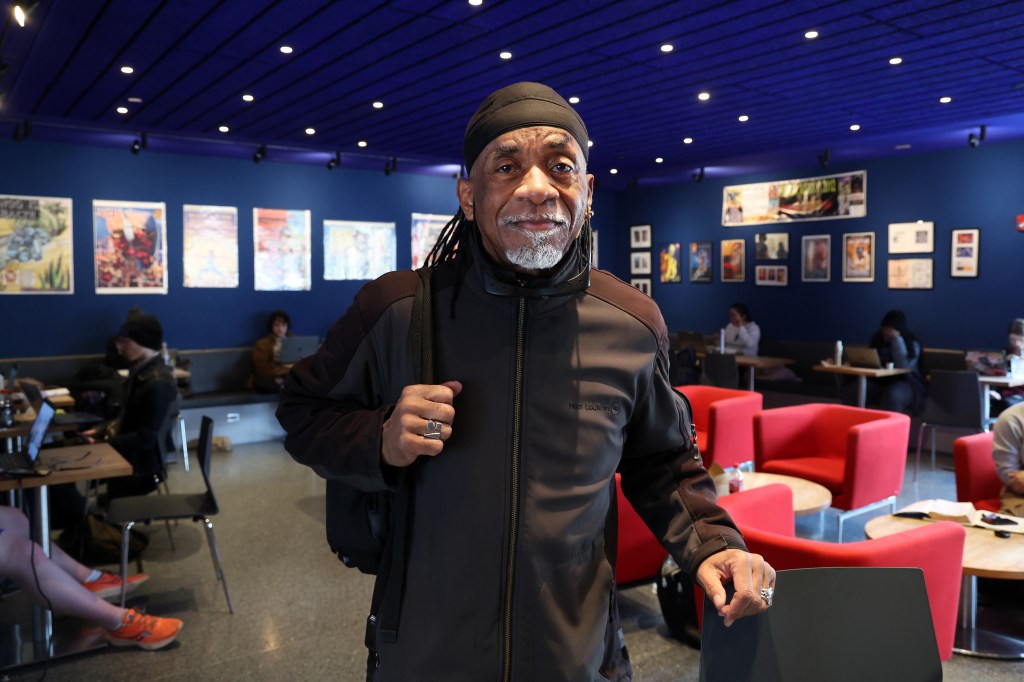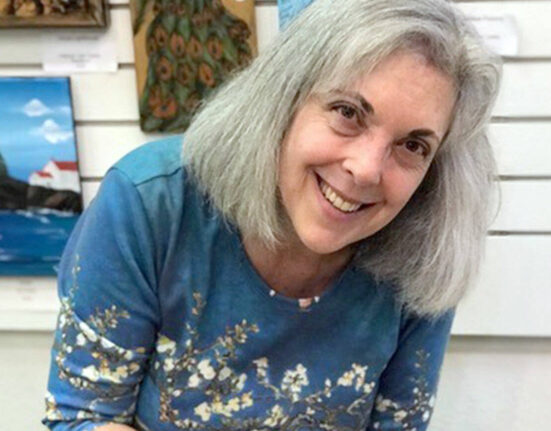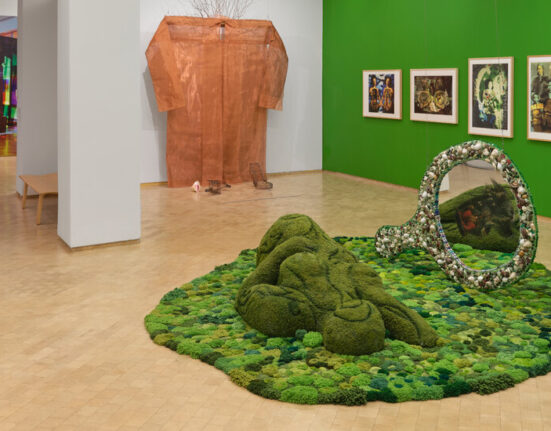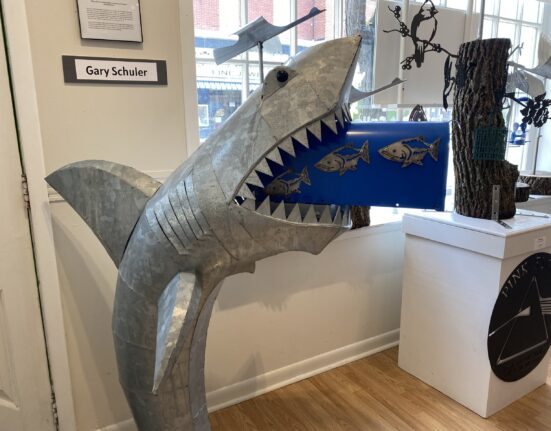Turtel Onli placed a stack of books, some mail and his bag on the table. He leaned in and said, raising his eyebrows somewhere between caution and politeness: “I hope you say in this article that I am still publishing, that I am still here and I am still an advocate for Black artists in comics. That exhibition I was in at the MCA a few years back? ‘Chicago Comics.’ Remember that? That show might as well have been called ‘Chris Ware and Friends.’ I appreciate that my character NOG was on the wall of the museum, like a billboard for the show, and on tote bags for the show. But do you know, I did not receive a single professional call from anyone who saw that show? Not galleries, publishers — nobody. Plus, people mentioned me in articles (about the show) like I was dead and gone! ‘Oh, so unfortunate about Turtel, how he is always being overlooked ….’”
But, I said, you are always overlooked.
“Yeah,” he said, “yeah, I know. But look at me now — that’s what I’m saying.”
We sat in the Café Logan, part of the Logan Center for the Arts, on the south edge of the University of Chicago campus in Hyde Park. We chose the spot because Onli has a new exhibition in the cafe — one that only served to underline the fact that Turtel Onli, pioneering comic book creator and one-man social network, remains obscure, literally overlooked: Though the cafe was packed with students, nearly everyone was hunched over their laptops, showing no signs of even noticing his works, inches from their heads.
When I walked into the cafe, my first thought was:
“Could someone give this guy a proper show?”
“You should say that in the article,” he said.
Turtel Onli wanted into the world of mainstream superhero comic books in the 1970s and 1980s. He was working as a courtroom artist for WGN-TV and illustrator for Chicago magazine, Ebony and Playboy (still based in Chicago back then). He left for Paris and illustrated for the English-language Paris Metro newspaper. He would go on to design album covers for several R&B and rap artists, including George Clinton and Kurtis Blow; for a hot minute, he was even commissioned by the Rolling Stones to create the album cover for 1978’s “Some Girls.” (“They wanted something absolutely offensive. I gave it to them. Lawyers stepped in, wisely, to say ‘You can’t show that.’”) His art was collected by Alice Coltrane and Miles Davis. Still, DC and Marvel said no.
So, in 1981, Onli, who grew up in Hyde Park and Albany Park, self-published a comic starring his own hero: NOG, Protector of the Pyramids. He sold it at art fairs and head shops. He went on to self-publish more comics, as well as self-help books on exercising and the zodiac, all sold as the work of Onli Studios. He never left the realm of curiosity.
Style, probably, has something to do with it.
Think the psychedelic cacophony of 1960s Jack Kirby Marvel comics meets the 1970s pulpiness of Heavy Metal magazine meets custom van decor meets the ornate obsessiveness of that friend you had in ninth grade who drew all day on school folders.
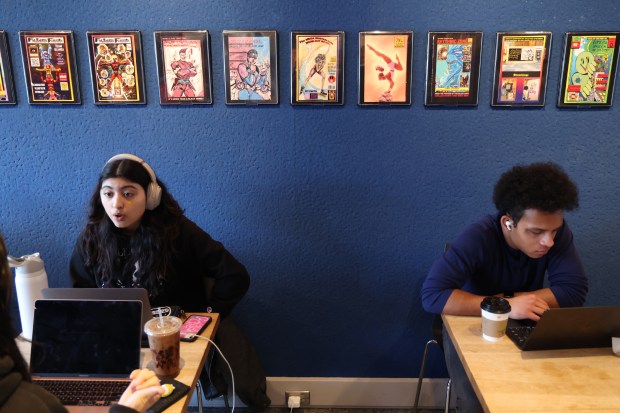
“Turtel jumps in with both feet, makes you turn your head sideways and wonder what you’re seeing exactly,” laughed the Decatur-based Afua Richardson, who first met Onli about a decade ago. He put her in touch with other Black comic book creators and soon after, she was drawing covers for both Marvel and DC. Recently, she drew the Spider-Punk character for the Oscar-nominated movie “Spider-Man: Across the Spider-Verse.”
“I think early on Turtel was trying to appeal to older Marvel and DC guys and Marvel and DC have house styles. And if you weren’t creating, say, the Kirby way, they weren’t going to let you join the club,” she said. “Turtel’s work is very much fine art, but also comic art.”
Richardson added: “Plus, he started at a time when few were thinking about futurism and Africa in the same sentence, and he was. He was bringing African aesthetics into comics when it wasn’t really popular. And that’s a whole other thing: When I was starting out, if I got a hair out of place, you would hear ‘Can we make this less urban?’”
Onli was a Black comic book artist trying to break into an almost entirely white industry — and in a very specific way. He refers casually to his style as “Rhythmism,” assuming you understand it. He means, art created with African and European influences, and a heady sprinkle of fantasy, suggesting past and future. But not Afrofuturism, he insists.
“I think of my work as future-primitive,” he says. “‘Primitive’ as in foundational. If one is down with cultural and artistic roots, there are standards that were there before us. At the same time, it is experimental. From a Black standpoint, it deals with the idea that we are Westerners in this country but there was a separation — and yet I also have genetic memory and a lot of cultural continuity, and when I work, these things can flow outward.”
Got that?
He would explain this to middle managers who just needed someone to draw Iron Man and Green Lantern. He would hear, “Do Black people understand science fiction?” and “Do Black people read?” He told me, “It’d get uncomfortable, because I would look at them like, OK, these people need help. It was also awkward because they would see the name ‘Turtel’ on a list of meetings and have no idea who or what I was. Also, NOD had dreadlocks, which is OK if you were Bob Marley. Not superheroes. He was defending a Black planet. I’d hear, ‘Wait, doesn’t he take on the KKK?’ No, and it’s not about penitentiary life, struggle, affirmative action or thug life. I’d say, ‘He’s defending a planet, not a village or even a hidden country,’ like Black Panther. And that was unheard of.”
Luke Cage defended mostly Harlem; Black Panther prowled mostly Wakanda.
Onli would have worked for the money and said he was once offered a $20,000 check for NOG (he declined to say the publisher), but “they would have owned everything and locked me down for 10 years. I was an idiot. I didn’t know better. I had no mentor. I was making better money with Playboy and Ebony, and I tore that check into molecules.”
Onli, of course, was far from alone in his frustration, so in 1993, with help from a few other aspiring Black comic book artists, he declared it “The Black Age of Comics,” playing off Marvel and DC practices, which had already segmented and repackaged their own blockbuster histories into the Golden (1938-1950), Silver (1956-1970) and Bronze Ages of Comics (1971-1985). Onli co-created the first Black Age of Comics Convention at the South Side Community Center. About 1,000 artists and fans attended and networked. Soon artist Dwayne McDuffie (who died in 2011) co-founded Black-centered Milestone Comics, which was published by DC. The Black Age of Comics conventions continued for decades, inspiring similar “Black Age of Comics” get-togethers in New York City, Detroit and Georgia.
But Onli stayed in Chicago.
He drew more and more comics, works such as “Malcolm-10,” playing off the early ‘90s popularity of Spike Lee’s “Malcolm X,” and featuring a genetically engineered vigilante who tracks down drug dealers and gang members and sends them to the Rhythm Zone.
Onli’s 72 now and said he began his career at 18, but really, it was earlier. His grandfather was a Chicago preacher, Rev. Samuel Phillips. “He was born in the 1800s and became known for drawing large depictions of the Bible, which he would use for his sermons. He would work on them in the apartment we lived in, his three sons all at the table drawing, and they would let me join in.” His grandfather’s Bible scenes — drawn onto oil cloths and window shades — would become well-known in outsider art circles.
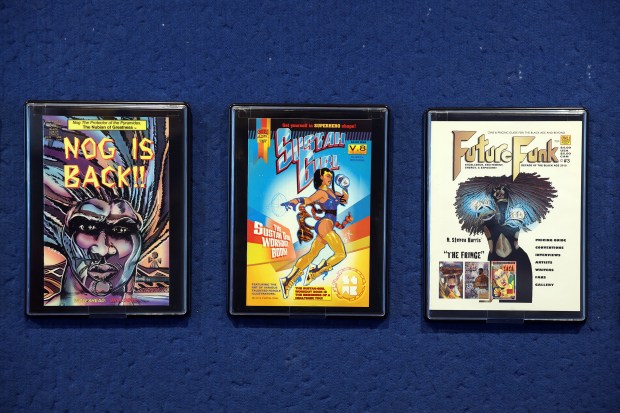
He said that all he cared about as a child was art. He would introduce himself in grade school as an artist. He was also good at basketball, “but when I wanted my parents to sign papers for a basketball scholarship, they would not and I got upset, so I was told I was ungrateful and had a few months left at home. When those months were over, I kissed them and I never went home again. I was raised by my grandparents, and went to Calumet Township High School (in the Auburn Gresham neighborhood).” He later attended the School of the Art Institute of Chicago and sold his first painting at 19, to Johnson Publishing, which needed art for its new building on South Michigan Avenue.
He left for France for a while, hoping his comics would find a better home. He returned and worked as an art teacher in Chicago Public Schools and as a clinical art therapist. These days, he teaches art appreciation and drawing at Harold Washington College. He uses himself as a lesson. Certainly, his work is distinctive, flowing, as if each image was cut away from some larger, giant mural. Dan Nadel, who curated the MCA show, said he’s drawn to Onli’s art “because it starts with cultural identity and builds fantasy and heroics from that base.” He thinks of it as “consciously ambitious takes” on the familiar.
That translates to a cult fandom, small enough that, other than Onli’s website, the only place to buy his comics in Chicago right now is the gift shop at the DuSable museum.
“I feel like I belong, but nobody gets it,” he told me.
He looked across the cafe, lined with his art.
“The beauty of this show is that you have all these young students right here. But the thing is, they don’t always turn around and see what’s hanging on a wall behind them.”
cborrelli@chicagotribune.com

